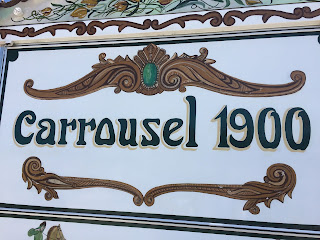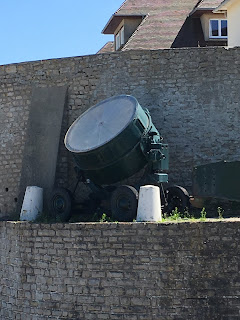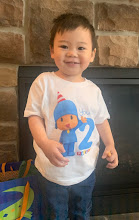The Grand Cascade
All of the desserts we've tried have been a work of art!
Today we took a trip to Normandy. Before our trip to Europe, I watched a documentary about Normandy. It was full of great information and helped me prepare for the day. It was on YouTube -
https://www.youtube.com/watch?v=N-P4GoG69Xw
One of the women in our tour group had a grandfather that was part of the naval attack on Omaha beach. He had been a spy for the American government and had joined the Nazi party in America in order to crack their codes. Once he joined the navy, he hand-picked his own crew for the D-Day mission. They landed on the Dog Red section of Omaha beach. He wrote a memoir about the event and Karen read it to us on the bus on our trip to Omaha beach. He explained the horror of losing 90% of his crew and seeing the massive amount of carnage on the beaches. He went into detail about the wounds and amount of blood that painted the shores that day. He described his guilt for having lived when so many others died. It was truly a remarkable story. Karen told us that her grandfather visited the same beach later in his life and sobbed for hours as he stood on the beach. I can only imagine the overwhelming fear and sadness of that fateful day. Normandy itself is a mix of medieval farms, memorials, and modern restaurants and inns. Life has continued, but the memory settles heavily on the land. You can feel the overwhelming sadness on the cliffs as you hear the lapping of the waves. The French people are so incredibly grateful for that day, despite the devastating destruction it brought to the peaceful fishing and farming towns. They know too well the price of freedom. It was a beautifully emotional day.
We started at Sword beech, which was on one end of the invasion. It was a British section. They had a welcome center with a video, which was very powerful.
Sword Beech -
The army's engineers turned parts of the boats into roadways for the tanks on the beaches.
Parts of the wall are still in tact. The breaker walls on the American shores were destroyed 12 days after the liberation by a large storm.
We moved across the beach, past Juno Beach (a Canadian section) into Gold Beech, where we had lunch. Gold Beech was another section for the British. The carousel was put on the beach in 1900. It's amazing how much of life changed during the occupation and then was able to continue because of the liberation. Another sign of the resilience of life.
Gold Beach -
The Restaurant we ate at
They've cleaned up much of the beach, but some parts of the ships remain.
Next, we went to one of the American cemeteries. The original cemetery was closer to the beach and was moved up on the cliff. There are 9,238 headstones and 1,557 names written on the wall (missing in action). There are 45 sets of brothers. It is a beautifully kept cemetery. The memorial center contains many stories of hers from that day. It also has a great deal of information about D-Day. It's amazing that so many strands of the army, in efforts with other countries, worked together that day for a common goal.
view of Omaha beach from the cemetery
grave of unknown soldier
Omaha & Utah Beach -
Omaha Beach has returned to a beach full of laughing kids and people swimming. I think it's a great tribute to the men who fought on the beach, that life has been able to go on, and that the beach has returned to the tourist center that it once was. The people of the area are well aware of the horrific events that took place on this beach. The blood that soaked the beach has washed away, the memory remains, and people enjoy freedom. I took a bottle of sand home with me, so I'll always remember.
high tide in the afternoon













































































































































































No comments:
Post a Comment